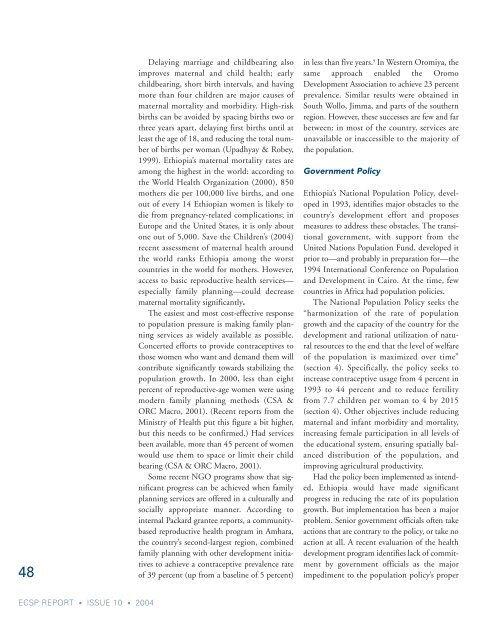Environmental Change and Security Project Report - Woodrow ...
Environmental Change and Security Project Report - Woodrow ...
Environmental Change and Security Project Report - Woodrow ...
You also want an ePaper? Increase the reach of your titles
YUMPU automatically turns print PDFs into web optimized ePapers that Google loves.
48<br />
Delaying marriage <strong>and</strong> childbearing also<br />
improves maternal <strong>and</strong> child health; early<br />
childbearing, short birth intervals, <strong>and</strong> having<br />
more than four children are major causes of<br />
maternal mortality <strong>and</strong> morbidity. High-risk<br />
births can be avoided by spacing births two or<br />
three years apart, delaying first births until at<br />
least the age of 18, <strong>and</strong> reducing the total number<br />
of births per woman (Upadhyay & Robey,<br />
1999). Ethiopia’s maternal mortality rates are<br />
among the highest in the world: according to<br />
the World Health Organization (2000), 850<br />
mothers die per 100,000 live births, <strong>and</strong> one<br />
out of every 14 Ethiopian women is likely to<br />
die from pregnancy-related complications; in<br />
Europe <strong>and</strong> the United States, it is only about<br />
one out of 5,000. Save the Children’s (2004)<br />
recent assessment of maternal health around<br />
the world ranks Ethiopia among the worst<br />
countries in the world for mothers. However,<br />
access to basic reproductive health services—<br />
especially family planning—could decrease<br />
maternal mortality significantly.<br />
The easiest <strong>and</strong> most cost-effective response<br />
to population pressure is making family planning<br />
services as widely available as possible.<br />
Concerted efforts to provide contraceptives to<br />
those women who want <strong>and</strong> dem<strong>and</strong> them will<br />
contribute significantly towards stabilizing the<br />
population growth. In 2000, less than eight<br />
percent of reproductive-age women were using<br />
modern family planning methods (CSA &<br />
ORC Macro, 2001). (Recent reports from the<br />
Ministry of Health put this figure a bit higher,<br />
but this needs to be confirmed.) Had services<br />
been available, more than 45 percent of women<br />
would use them to space or limit their child<br />
bearing (CSA & ORC Macro, 2001).<br />
Some recent NGO programs show that significant<br />
progress can be achieved when family<br />
planning services are offered in a culturally <strong>and</strong><br />
socially appropriate manner. According to<br />
internal Packard grantee reports, a communitybased<br />
reproductive health program in Amhara,<br />
the country’s second-largest region, combined<br />
family planning with other development initiatives<br />
to achieve a contraceptive prevalence rate<br />
of 39 percent (up from a baseline of 5 percent)<br />
in less than five years. 9 In Western Oromiya, the<br />
same approach enabled the Oromo<br />
Development Association to achieve 23 percent<br />
prevalence. Similar results were obtained in<br />
South Wollo, Jimma, <strong>and</strong> parts of the southern<br />
region. However, these successes are few <strong>and</strong> far<br />
between; in most of the country, services are<br />
unavailable or inaccessible to the majority of<br />
the population.<br />
Government Policy<br />
Ethiopia’s National Population Policy, developed<br />
in 1993, identifies major obstacles to the<br />
country’s development effort <strong>and</strong> proposes<br />
measures to address these obstacles. The transitional<br />
government, with support from the<br />
United Nations Population Fund, developed it<br />
prior to—<strong>and</strong> probably in preparation for—the<br />
1994 International Conference on Population<br />
<strong>and</strong> Development in Cairo. At the time, few<br />
countries in Africa had population policies.<br />
The National Population Policy seeks the<br />
“harmonization of the rate of population<br />
growth <strong>and</strong> the capacity of the country for the<br />
development <strong>and</strong> rational utilization of natural<br />
resources to the end that the level of welfare<br />
of the population is maximized over time”<br />
(section 4). Specifically, the policy seeks to<br />
increase contraceptive usage from 4 percent in<br />
1993 to 44 percent <strong>and</strong> to reduce fertility<br />
from 7.7 children per woman to 4 by 2015<br />
(section 4). Other objectives include reducing<br />
maternal <strong>and</strong> infant morbidity <strong>and</strong> mortality,<br />
increasing female participation in all levels of<br />
the educational system, ensuring spatially balanced<br />
distribution of the population, <strong>and</strong><br />
improving agricultural productivity.<br />
Had the policy been implemented as intended,<br />
Ethiopia would have made significant<br />
progress in reducing the rate of its population<br />
growth. But implementation has been a major<br />
problem. Senior government officials often take<br />
actions that are contrary to the policy, or take no<br />
action at all. A recent evaluation of the health<br />
development program identifies lack of commitment<br />
by government officials as the major<br />
impediment to the population policy’s proper<br />
ECSP REPORT • ISSUE 10 • 2004

















